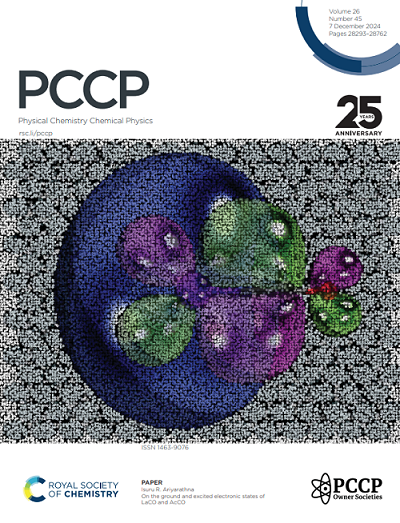2,4,6-Triphenyl-1,3,5-Triazine Functionalized fac-tris(2-phenylpyridine)Ir(III) Complexes with Polarity Sensitive T1 State Properties
IF 2.9
3区 化学
Q3 CHEMISTRY, PHYSICAL
引用次数: 0
Abstract
Here we report the synthesis and study of three Ir(III) complexes, which are derivatives of fac‑Ir(ppy)3 (Hppy – 2-phenylpyridine). In these derivatives the third position of the pyridine ring of one of the ppy ligands is functionalized with a tolyl (Ir‑tol), or triphenyl triazine group (Ir‑meta and Ir‑para). Ir‑meta has a 3-(3,5-diphenyl-2,4,6-triazinyl)phenyl group on the ppy pyridyl, giving a meta disposition of the triazine to the ppy ligand and Ir‑para has a 4-(3,5-diphenyl-2,4,6-triazinyl)phenyl group bound to the ppy ligand putting the triazine moiety para to the ppy ligand. Complex Ir‑tol shows electrochemical properties and phosphorescence characteristics nearly identical to those of the unfunctionalized fac-Ir(ppy)3. Complexes Ir‑meta and Ir‑para show reduction potentials that are anodically shifted from those of Ir‑tol by ca. 0.6 V, consistent with reduction centered on the triazine moiety. In the non-polar media, the lowest triplet state (T1) of Ir‑meta and Ir‑para has mixed metal-to-ligand charge transfer (MLCT) and ligand centered (LC) character localized on the Ir-ppy moiety of the functionalized ligand. With an increase in solvent polarity. i.e. CH2Cl2 and dimethyl sulfoxide (DMSO), the T1 state of these complexes gains character of intraligand charge transfer (ILCT) from Ir-ppy to the triazine moiety of the functionalized ligand. This change in excited state character is accompanied by a distortion in the molecular geometry towards planarization of the acceptor and donor units. Such polarity-controlled modulation of T1 state character is traced with transient absorption (TA) spectroscopy and is found to markedly affect photoluminescent properties of the complexes.具有极性敏感T1态性质的2,4,6-三苯基-1,3,5-三嗪功能化面-三(2-苯基吡啶)Ir(III)配合物
本文报道了三个Ir(III)配合物的合成和研究,这三个配合物是fac - Ir(ppy)3 (happy - 2-苯基吡啶)的衍生物。在这些衍生物中,其中一个对苯基配体的吡啶环的第三位被甲苯(Ir - tol)或三苯基三嗪(Ir - meta和Ir - para)功能化。在吡啶基上有一个3-(3,5-二苯基-2,4,6-三嗪基)苯基,使三嗪对ppy配体有一个间位配置,而在吡啶配体上有一个4-(3,5-二苯基-2,4,6-三嗪基)苯基,使三嗪部分对ppy配体。配合物Ir - tol的电化学性能和磷光特性与未功能化的面-Ir(ppy)3几乎相同。配合物Ir - meta和Ir - para的还原电位与Ir - tol的还原电位相差约0.6 V,与以三嗪基团为中心的还原一致。在非极性介质中,Ir- meta和Ir- para的最低三重态(T1)具有混合金属-配体电荷转移(MLCT)和定位于功能化配体Ir-ppy部分的配体中心(LC)特征。随着溶剂极性的增加。如CH2Cl2和二甲基亚砜(DMSO),这些配合物的T1态获得了从i -ppy到功能化配体的三嗪部分的配体内电荷转移(ILCT)的特征。激发态特征的这种变化伴随着分子几何结构的扭曲,使受体和供体单元趋于平面化。这种对T1态特性的极性控制调制用瞬态吸收(TA)光谱进行了追踪,并发现它显著地影响了配合物的光致发光特性。
本文章由计算机程序翻译,如有差异,请以英文原文为准。
求助全文
约1分钟内获得全文
求助全文
来源期刊

Physical Chemistry Chemical Physics
化学-物理:原子、分子和化学物理
CiteScore
5.50
自引率
9.10%
发文量
2675
审稿时长
2.0 months
期刊介绍:
Physical Chemistry Chemical Physics (PCCP) is an international journal co-owned by 19 physical chemistry and physics societies from around the world. This journal publishes original, cutting-edge research in physical chemistry, chemical physics and biophysical chemistry. To be suitable for publication in PCCP, articles must include significant innovation and/or insight into physical chemistry; this is the most important criterion that reviewers and Editors will judge against when evaluating submissions.
The journal has a broad scope and welcomes contributions spanning experiment, theory, computation and data science. Topical coverage includes spectroscopy, dynamics, kinetics, statistical mechanics, thermodynamics, electrochemistry, catalysis, surface science, quantum mechanics, quantum computing and machine learning. Interdisciplinary research areas such as polymers and soft matter, materials, nanoscience, energy, surfaces/interfaces, and biophysical chemistry are welcomed if they demonstrate significant innovation and/or insight into physical chemistry. Joined experimental/theoretical studies are particularly appreciated when complementary and based on up-to-date approaches.
 求助内容:
求助内容: 应助结果提醒方式:
应助结果提醒方式:


